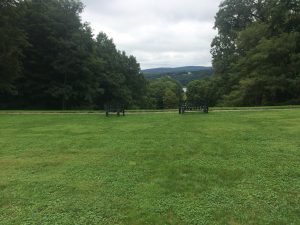Maple Grove and Locust Grove: Preserving History and Land
September 16, 2018 by jumorel
This past Friday our course visited Maple Grove and Locust Grove, two historic sites of the Hudson Valley. Although they are both places of significance, their management and upkeep differ greatly.
Maple Grove is funded by the NY Environmental Protection Fund, paid for by the public’s tax dollars. Previously home to a wealthy banker, the large yellow estate is surrounded by land that was previously utilized for farming, though now several trees and shrubbery have grown throughout the land, obscuring what used to be a clear view of the landscape. Though this property used to be of great value, someone hoping to demolish the house and create space for condos set fire to the house in 1985. Because the fire has made the building so expensive to renovate, plans to fix it up have been progressing quite slowly over the past few years, and the manor’s interior is closed to the public due to safety regulations. Beyond this information, not much can be gained, as there are no tour guides or placards to educate the public about the site.

Maple Grove Manor
Locust Grove, on the other hand, is much better maintained and has regular staff that work to promote upkeep and publicity. This also means that they can support educational initiatives; during our visit Ken provided us with a thorough historical background of Locust Grove. The 200 acres of gardens and grounds was first owned and named by the Livingston family in the 1770s for the black locust trees surrounding the property along Route 9. In the 1850s 125 acres were bought by Samuel Morse to be used as his summer home. The first of a dozen big estates in the region, Locust Grove was acquired by Mr. and Mrs. Young in the 1890s when Morse died. A wealthy family that owned most of Poughkeepsie at that time, the Youngs purchased 100 acres, which was later inherited by their daughter Annette Young in the 1950s. She declared in her will that the property be utilized as a museum and nature preserve, so when the current owners acquired 140 acres, they put in the effort to make this happen. In 2006, 35 more acres were acquired for $2.5 million from what was to be a condo area. The independent, not-for-profit owners do not receive funds from local or federal government except for use of grants from capital projects, so 70% of their progress depends on private sources. Their operating budget of $1 million is gained mostly from party rentals, as well as entrance fees, school trips, the gift shop, and donations, though these can be difficult to raise. The grounds are free to the public though, and school trips are often subsidized, agreeing with Annette Young’s wishes. Open 8am to dusk, the grounds take extensive maintenance work. With a garden staff of two, it can be difficult to constantly keep up the fences that protect the land from ten times the amount of white-tailed deer in the area as there should be. Additionally, their new educational building with classrooms, storage, lecture rooms, exhibits, and rental rooms takes a lot to maintain, and they are finding that as much publicity as they do, their tourism is not increasing. Despite the fact that 48,000 cars pass their gates each day, that they put on approximately 50 weddings per year and often change exhibits and family activity options, Ken says that their visitors are often local, and revenue isn’t increasing much.

Locust Grove Viewshed
Nonetheless, the museum holds fantastic historical treasures. Due to the 10,000 photographs stored in their archives, the staff can set up rooms of the old house just as they were decades ago, down to the exact details, and 300 family diaries show exactly how daily life was at that time. Furthermore, the extensive grounds and trails provide a beautiful respite from busy day-to-day life and are a welcome change of scenery.
Perhaps most interesting to me was Ken’s explanation about why the museum no longer advertises the site as Samuel Morse’s historic property. A man with a problematic and complex political career, Morse was pro-slavery, anti-Catholic, and essentially “didn’t like anybody who wasn’t a Morse.” The museum’s choice not to advocate for or engage with that history has been described by Ken as a way for them to celebrate the history, art, and life of the Youngs rather than that of Morse.
Our visit to these two sites are exemplary of the impacts that funding can have on preservation of sites. Maple Grove’s public funding doesn’t provide much for tourists to see, while Locust Grove’s private funding, though exhaustive and difficult to maintain, keep the historic site accessible and open to the interested public. Just a few minutes driving distance from each other, it is easy to visit both in one trip – take a visit and explore the fascinating history and preservation of the Hudson Valley for yourself!